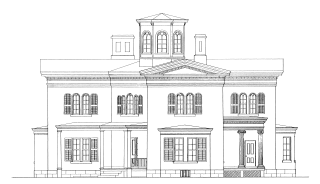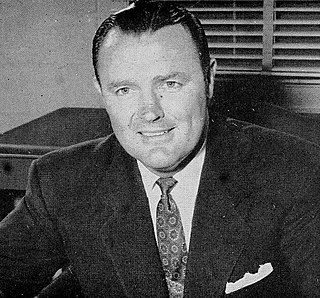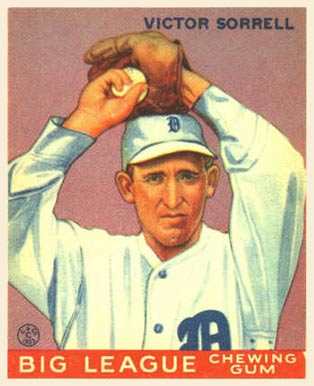Related Research Articles
Cooleemee is a town in Davie County, North Carolina, United States. The population was 960 at the 2010 census.

Statesville is a city in and the county seat of Iredell County, North Carolina, United States, and it is part of the Charlotte metropolitan area. Statesville was established in 1789 by an act of the North Carolina Legislature. The population was recorded as 95 in the 1800 Census. The population was 28,419 at the time of the 2020 census.

Cooleemee, also known as the Cooleemee Plantation House, is a house located between Mocksville and Lexington, North Carolina, at the terminus of SR 1812 on the Yadkin River in Davie County, North Carolina. It is a U.S. National Historic Landmark, designated in 1978 for its architecture.
The Cincinnati Tigers were a professional Negro league baseball team that was based in Cincinnati, Ohio.

Baxter Byerly "Buck" Jordan was a first baseman in Major League Baseball who played for the New York Giants (1927–1929), Washington Senators (1931), Boston Braves (1932–1937), Cincinnati Reds (1937-1938) and Philadelphia Phillies (1938). Jordan batted left-handed and threw right-handed. He was born in Cooleemee, North Carolina.

James Moore "Big Jim" Tatum was an American football and baseball player and coach. Tatum served as the head football coach at the University of North Carolina at Chapel Hill, the University of Oklahoma (1946), and the University of Maryland, College Park (1947–1955), compiling a career college football record of 100–35–7. His 1953 Maryland team won a national title. As a head coach, he employed the split-T formation with great success, a system he had learned as an assistant under Don Faurot at the Iowa Pre-Flight School during World War II. Tatum was also the head baseball coach at Cornell University from 1937 to 1939, tallying a mark of 20–40–1. Tatum's career was cut short by his untimely death in 1959. He was inducted into the College Football Hall of Fame as a coach in 1984.

Victor Garland Sorrell, nicknamed "Lawyer" and "The Philosopher," was a Major League pitcher who played his entire career with the Detroit Tigers. In 10 Major League seasons, Sorrell had a 92–101 record with a 4.43 career ERA. Sorrell also coached the North Carolina State University baseball team from 1946 to 1966.
Thomasville, North Carolina was home to several minor league baseball teams from 1937–1969.
Zebulon Vance Eaton, nicknamed "Red", was an American right-handed pitcher. He played professional baseball for 11 seasons between 1939 and 1956, including two seasons in Major League Baseball with the Detroit Tigers in 1944 and 1945.
The North Carolina State League was a "Class D" league in Minor League Baseball. The original version of the league existed from 1913–1917 as the successor to the Carolina Association. The second version of the league was established in 1937 in part in order to compete with the Piedmont-region independent league, the Carolina League, and ran through 1953 when it combined with the Western Carolina League to form the Tar Heel League.
The Bi-State League was an American baseball minor league formed in 1934 with teams in Virginia and North Carolina. The league held together for nine seasons, being represented by ten cities from North Carolina and eight from Virginia. Only the Leaksville-Draper-Spray Triplets, a team that was a combination of those three cities from North Carolina, was able to make the entire nine-year run. This combination also captured the league title in two seasons, 1935 and 1941. The squad from Bassett, Virginia, won four league titles during the span, coming out on top three times in a row, 1936, 1937, 1938 and closing it out with the 1940 pennant before losing in the finals. The league's final season was 1942, as it was not revived after World War II.
The Carolina Textile League was a semi–professional baseball league that played in the 1935 season. The league members were located in the Piedmont region of North Carolina. The league evolved into the Carolina League in 1936.
Several different minor league baseball teams were based in Salisbury, North Carolina, between 1905 and 1968.
The Concord Weavers were a minor league baseball team based in Concord, North Carolina. Between 1936 and 1951, Concord teams played as a member of the Independent level Carolina League from 1936 to 1938 and the Class D level North Carolina State League from 1939 to 1942 and 1945 to 1951, winning two league pennants and one championship. The franchise played as the Concord Nationals from 1949 to 1950 and Concord Sports in 1951, with Concord teams hosting minor league home games at Webb Field.
The Mooresville Moors were a minor league baseball team based in Mooresville, North Carolina. Between 1936 and 1953, the Mooresville Moors teams played as members of the 1936 Carolina League, the North Carolina State League from 1937 to 1942 and 1945 to 1952 before playing a final season in the 1953 Tar Heel League. The Mooresville Moors won six North Carolina State League Championships. For one season, the team became known as the Mooresville "Braves," playing the 1945 season as a minor league affiliate of the Boston Braves. The Moors and Braves hosted minor league home games at Mooresville Park.
The Lenoir Red Sox was the primary moniker of the minor league baseball teams based in Lenoir, North Carolina. Between 1937 and 1951, Lenoir teams played as members of the 1937 and 1938 Carolina League, 1939 and 1940 Tar Heel League, 1946 and 1947 Blue Ridge League and the Western Carolina League from 1948 to 1951, winning three league championships. Lenoir hosted home minor league games at the Lenoir High School Field. The 1940 Lenoir Reds were a minor league affiliate of the Cincinnati Reds and the Lenoir Red Sox were an affiliate of the New York Giants from 1949 to 1951.
The Williamston Martins were a minor league baseball team based in Williamston, North Carolina. From 1937 to 1941, the Martins played as exclusively as members of the Coastal Plain League, winning the 1939 league championship. Williamston hosted home minor league games at Taylor Field.
The Kannapolis Towelers were a minor league baseball team based in Kannapolis, North Carolina. From 1936 to 1941, the Towelers played as members of the Carolina League from 1936 to 1938 and North Carolina State League from 1939 to 1941, winning three league pennants. The Towelers hosted home minor league games at the Kannapolis Ballpark.
The Newton–Conover Twins were a minor league baseball team based in Newton, North Carolina, in partnership with Conover, North Carolina. Newton–Conover Twins teams played as members of the North Carolina State League in 1937 and 1938, Tar Heel League in 1939 and 1940 and the Western Carolina League from 1948 to 1951 and again from 1961 to 1963. The Twins played home minor league games in Newton, Carolina.
Minor league baseball teams were based in Lexington, North Carolina between 1937 and 1967. Lexington teams played as members of the Carolina League in 1936, North Carolina State League from 1937 to 1942 and 1945 to 1952, Tar Heel League in 1953 Western Carolina League from 1960 to 1961 and Western Carolinas League from 1963 to 1967. Lexington won two league championships.